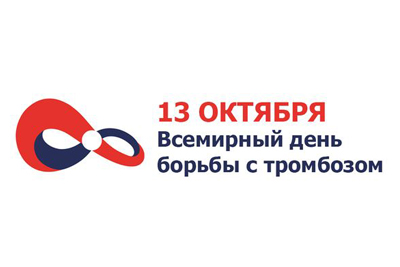
The International Day of Struggle against Thrombosis complements the already existing International Heart Day and International Day of Struggle against Stroke, informing the public about cardiovascular diseases. The date of October 13 was not chosen by chance — it was on this day that Rudolf Virchow, a German pathologist, the founder of the pathophysiology of thrombosis, was born.
Thrombosis is the lifetime formation of blood clots (thrombi) inside blood vessels, whether arteries or veins. The consequence of this is a violation of the free movement of blood through the vascular system. If a blood clot forms in the arteries, then the flow of blood (and, accordingly, oxygen) to the tissues decreases, symptoms of hypoxia (oxygen starvation) appear. With extensive arterial thrombosis, complete oxygen deprivation and death of organ cells and tissues (brain, heart, etc.) can develop. Thrombi in venous vessels usually do not lead to ischemia and hypoxia of tissues at the site of their formation, however, they, in turn, are dangerous for the development of so-called venous thromboembolism, when a blood clot migrates (detaches), usually into a small circulatory circle, leading, depending on the massiveness of thrombosis, to a violation of venous blood circulation in the lungs with all the ensuing consequences.
It should be noted that thrombosis is a normal reaction of the body to damage to a vessel, created by evolution to stop bleeding. However, thrombosis caused by other causes can lead to diseases with high mortality, such as stroke, myocardial infarction, pulmonary thromboembolism, etc.
According to the cardiovascular surgeon, associate professor of the Department of General Surgery of KSMU, Candidate of Medical Sciences Mikhail Borisovich SUKOVATYKH, experts identify three main causes of thrombosis. I’m just quoting data that has been a postulate for doctors for more than 100 years and has been formulated by Virchor:
- Damage to the vessel wall (injuries, surgical interventions, etc.);
- Slowing of blood flow (prolonged stationary position, accompanied by a decrease in blood flow rate);
- Hypercoagulation or a change in blood viscosity, the so-called “thick blood”.
Thrombosis acquired significant relevance during the COVID-19 pandemic. According to the Ministry of Health of Russia, the risk of developing thrombosis is quite high – a tendency to thrombosis is noted in every third postcovid patient. The infection is accompanied by almost all the factors described by Virchor, which leads to an increase in the number of thrombotic complications. However, people with endocrine diseases (diabetes mellitus), overweight (obesity), chronic heart and vascular diseases are especially predisposed to thrombosis – in these categories, the risk of developing thrombosis is much higher. If people with the listed diseases become infected with COVID-19, then the cause of death for them is most often thrombotic complications, M.B. Sukovatykh notes.
To reduce the likelihood of developing thrombosis, the following is necessary:
The first and most important thing is the understanding that it is much easier to prevent the disease than to treat it and its consequences (thrombosis) later. Accordingly, vaccination against COVID-19 and compliance with the main prevention recommendations developed by WHO (wearing masks, etc.) are necessary.
Information about COVID-19 and thrombosis from pseudoscientific sources, such as social networks, should not be trusted. The whole scientific world is working on a strategy for the treatment and prevention of this disease, and the data obtained are summarized in clinical recommendations, which are guided by doctors in the treatment of their patients.
In no case should you take medications that affect the hemostasis system, the so-called blood thinners on your own. The choice of the drug is made only by a doctor who, according to Russian clinical guidelines, selects the necessary drug, selects the effective dosage, calculates the duration of administration and performs laboratory and clinical control of the effectiveness of treatment.
The following recommendations will also help reduce the likelihood of thrombosis.
- Adhere to a special diet. Avoid fatty meats and offal, hard and soft fatty cheeses, fatty dairy products, butter and combined fats, smoked meats, sausages, dried and salted fish, chips, fast food, lemonade, sweets, milk chocolate, pastries, potatoes, fatty sauces.
- Be sure to observe a sufficient drinking regime: the daily norm for an adult is from 1.5 to 2.5 liters of water per day, depending on body weight, which will reduce blood viscosity.
- Give up bad habits (especially alcohol and smoking).
- Do not wear outerwear that squeezes individual parts of the body (for example, tight jeans, belts, corsets, uncomfortable shoes).
- Avoid both hypothermia and too hot weather, it is not advisable to take hot baths.
- Strengthen the immune system, which protects you from infection, by observing simple rules of a healthy lifestyle, such as spending more time outdoors, fighting physical inactivity with adequate physical exertion, etc.
These simple tips are relevant not only for patients with thrombosis but for all of us. Well, if you suspect something, then do not self-medicate – contact an experienced specialist!
